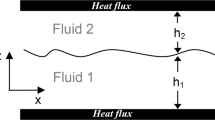Abstract
The electrothermoconvective instability of a plane horizontal layer of weakly conducting fluid in a modulated vertical electric field is investigated. The analysis is based on the electrohydrodynamic approximation. The stability threshold in the linear approximation is found using Floquet’s theory. The effect of periodic modulation on the fluid behavior is studied in both the presence and the absence of the constant component of the electric field. It is shown that modulation can stabilize the unstable ground state or destabilize fluid equilibrium, depending on the amplitude and frequency. In addition to a synchronous or subharmonic response to an external forcing, the instability may be associated with two-frequency (quasiperiodic) perturbations. The cases of weightlessness and a transversely stratified fluid in a static gravity field are considered.
Similar content being viewed by others
References
M. J. Gross and J. E. Porter, “Electrically induced convection in dielectric liquids,” Nature,212, No. 5068, 1343–1345 (1966).
R. J. Turnbull, “Electroconvective instability with a stabilizing temperature gradient. II. Experimental results,” Phys. Fluids,11, 2597–2603 (1968).
R. V. Kosvintsev, “Experimental investigation of convection in a plane layer of nonuniformly heated, weakly conducting fluid,” Bull. Perm Univ., No. 2, 128–140 (1994).
Ch.-O. Lee, “Thermal instability of a slightly conducting liquid layer in a vertical electric field,”Heat Transfer. Proc. 5th Intern. Heat Transfer Conf. Tokyo. 1974 s.a. V. 3, 173–177 (1974).
R. J. Turnbull, “Electroconvective instability with a stabilizing temperature gradient. I. Theory,” Phys. Fluids,11, 2588–2596 (1968).
V. A. Saranin, “Instability of equilibrium of a plane horizontal layer of nonuniformly heated fluid in an electric field,”Convective Flows [in Russian], Perm Teacher’s Training College Press, Perm, 46–52 (1983).
M. K. Bołoga, F. P. Grosu, and I. A. Kozhukhar,Electroconvection and Heat Exchange [in Russian], Shtiintsa, Kishinev (1977).
G. Z. Gershuni and E. M. Zhukhovitskii,Convective Instability of an Incompressible Fluid [in Russian], Nauka, Moscow (1972).
G. Z. Gershuni, I. O. Keller, and B. L. Smorodin, “On vibrational-convective instability in weightlessness: finite frequencies,” Dokl. Ros. Akad. Nauk,348, 194–196 (1996).
G. Z. Gershuni, A. A. Nepomnyashchy, B. L. Smorodin, and M. G. Velarde, “On parametric excitation of thermocapillary and thermogravitational convective instability,” Micrograv. Quart.,4, No. 4, 215–220 (1994).
G. I. Petrov, “Application of the Galerkin method to the problem of stability of a viscous fluid flow,” Prikl. Mat. Mekh.,4, No. 3, 3–12 (1940).
L. D. Landau and E. M. Lifshits,Theoretical Physics, V. 3. Quantum Mechanics [in Russian], Nauka, Moscow, p. 768 (1989).
Additional information
Madrid, Perm’. Translated from Izvestiya Rossiiskoi Akademii Nauk, Mekhanika Zhidkosti i Gaza, No. 3, pp. 31–38, May–June, 2000.
The investigations whose results are presented in this paper were supported by the Russian Foundation for Basic Research (project No. 98-01-00507).
Rights and permissions
About this article
Cite this article
Velarde, M.G., Smorodin, B.L. Convective instability of a plane horizontal layer of weakly conducting fluid in alternating and modulated electric fields. Fluid Dyn 35, 339–345 (2000). https://doi.org/10.1007/BF02697746
Received:
Issue Date:
DOI: https://doi.org/10.1007/BF02697746




